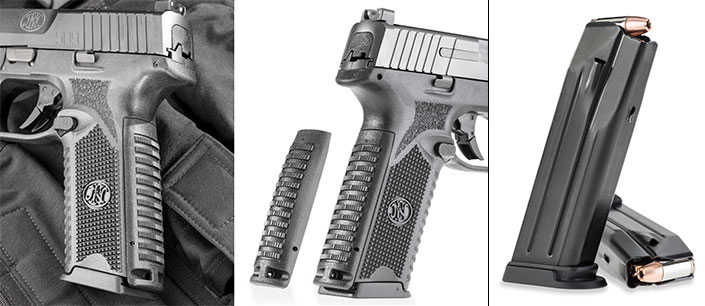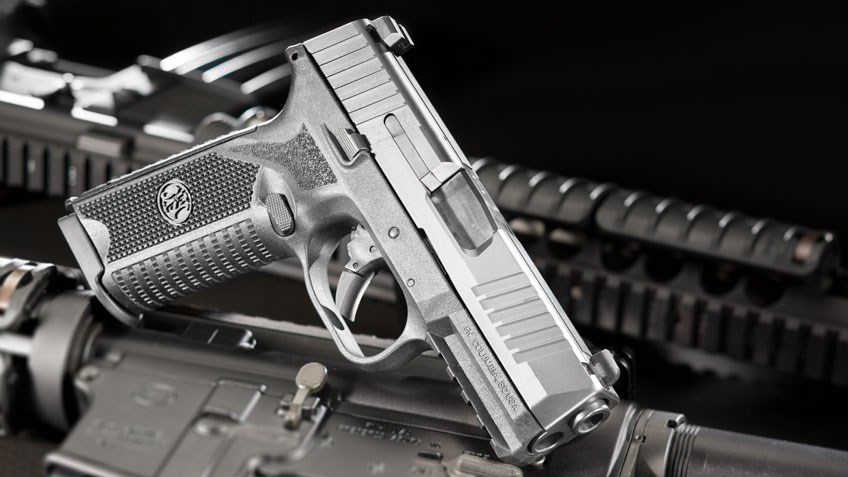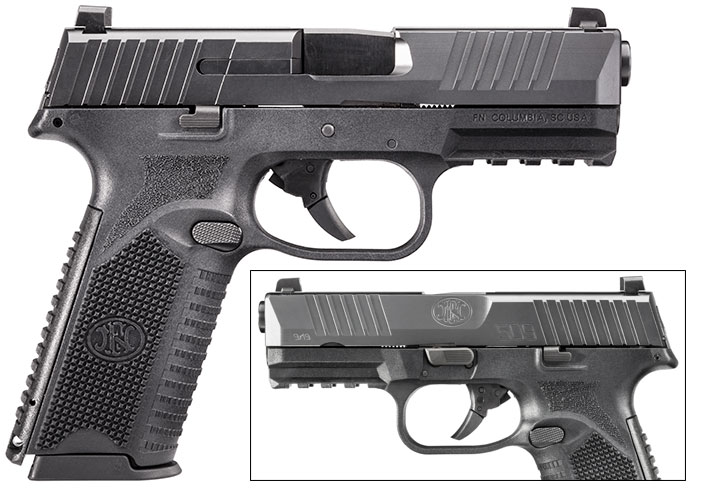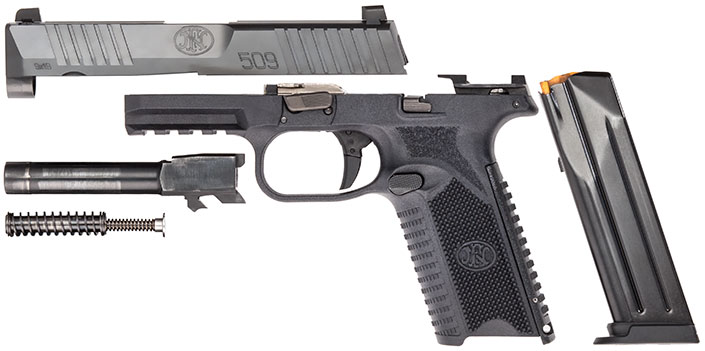Here’s a close look at FN’s entrant in the Army’s XM17 trials. It turns out there weren’t really any losers, and the big winner was the American pistol shooter. Read all about it…
SOURCE: NRA Staff, by Tamara Keel
The Army’s XM17 Modular Handgun System (MHS) competition ended up delivering an embarrassment of riches to the American pistol shooter. The Sig Sauer P320 MHS won, but several of the runners-up have found their way to gun dealers’ shelves in the months since the competition ended. This is the offering from Fabrique Nationale, which has trickled to the commercial market as the FN 509.
While not the exact gun used in the trials, it is, I want to say, “close enough for government work,” but that would be a lame joke. It would be somewhat true, though, since between the MHS contest and the release of the 509 to the market, FN met with representatives from law enforcement agencies to solicit input on various changes that would make its XM17 entrant more marketable to the domestic-law-enforcement market.
Basically, the FN 509 is an improved version of its existing striker-fired, polymer duty gun, the FNS, which has seen some success in both law enforcement and in the action-pistol world. The new version features a plethora of modifications from the familiar FNS, some to fit specific requirements of the MHS contract and others to make it an even more attractive choice as a fighting pistol than its predecessor.
Gone is the slight beavertail on the back of the full-size FNS frame; the FN 509 has the more rounded contour of the FNS Compact. I’m assuming this has something to do with the maximum overall length specified by the MHS program. The gun measures overall at just under 7.5 inches.
The slide on the FN 509 is similar to that of its progenitor, but the grasping grooves fore and aft are more aggressive, and worked well even with hands that were slippery with sweat and sunscreen. The slide boasts a satin-textured, rust-resistant finish.
The sight dovetails are dimensionally identical to those of Springfield Armory XD and Sig Sauer. This means there are a variety of aftermarket sighing options. Unlike the factory sights on the FNS, the 509’s rear-sight body features a bluff front rather than a Novak-style slope, the better to perform one-handed malfunction clearances by running the slide off a boot heel, belt, or holster mouth.

(left) More-aggressive front serrations aid in press-checks and slide manipulation. (center) Want to change the white dot up front? Numerous options exist. (right) The rear sight’s front face is a ledge for one-handed racking of the slide.
The grip on the FN 509 is full-size, as it must be to accommodate the 17-round magazines specified by the program. The gripping surface textures are a quilt-like combination pattern of pyramid-shaped raised points of varying sizes as well as “skateboard tape” style accents. It looks odd, but it works fine. One of my last days with the gun was spent at a very hot and humid indoor range. Even dripping with sweat, the FN 509 had enough texture in the right places to allow me to shoot 4- and 5-round strings rapid fire without feeling like I was trying to hold onto a bar of soap.

The bottom of the grip on the FN 509 is heavily scalloped on the sides to permit a good grip if one needs to rip a magazine out to clear a malfunction. When I unpacked the gun, I field-stripped it and lubricated it with a few drops of Lucas Extreme Duty Gun Oil in the usual places, and then commenced to shooting. Over the course of the next 784 rounds without any further lubrication or cleaning, the gun suffered one user-induced failure-to-feed, on the last magazine, trying to provoke a “limp-wrist” malfunction with some Speer 147-grain TMJ Lawman ammo.
One of the stated goals of the MHS program was to get a gun that was as adaptable to the gamut of end users as possible, regardless of hand size or hand preference. Implementation of this ranged from the completely swappable frame shells of the SIG Sauer P320, to the wraparound backstraps of the Smith & Wesson M&P M2.0, to the Glock entry’s add-on backstraps carried over from the company’s Gen4 offering. The FN 509, by way of contrast, ships with two interchangeable inserts that take up the lower three quarters of the backstrap. There is a choice between either arched or flat, and neither really alters the reach to the trigger. No worries about it being too large for any end user, though, since the circumference around the trigger is, at just less than 7 inches, less than an eighth of an inch more than an M&P with the small backstrap and barely a quarter-inch greater than even a diminutive single-stack 9 mm like the Walther CCP.
Trigger pull weighed in at a consistent 6 pounds on my scale, with a light takeup that met an abrupt wall, and then broke cleanly. Before I actually put it on the scale, I would have bet money that the trigger broke at 5 pounds — it feels lighter than it is.
Trigger reset was distinct and short. It was easy to shoot this gun well. My very first day at the range, I pulled it out of its box, lubed it to spec, and used the first 50 rounds from the gun to shoot a clean Dot Torture drill, cold. This impressed me even more, since the last three days had seen me consistently dropping a shot for a 49/50 with my Glock G19 carry gun.

The barrel of the FN 509 features a thicker bearing area around the muzzle, with a smaller contour along the remaining barrel length, which shaves ounces compared to a full-thickness barrel for the entire length. This likely contributes to my postal-scale measured empty weight of 26.5 ounces. Even with 17+1 rounds of 124-grain Federal Premium HST in the gun, it still weighed only 34.3 ounces, which is well less than an empty M1911 Government model.
The muzzle’s crown is countersunk to enhance accuracy and protect it from damage. Grabbing three different factory loads at random from my ammo stash, accuracy testing was performed at 15 yards shooting off sandbags. Two of the loads, Winchester NATO 124-grain FMJ and Federal 147-grain +P HST Tactical, turned in best five-shot groups smaller than 2 inches. Even steel-cased Russian TulAmmo 115-grain FMJ turned in a couple groups right about 2 inches. (The TulAmmo, or at least this lot, was also amazingly consistent, velocity-wise, from the FN 509, with a standard deviation for the 10-round string of only 10.77 fps.)
The FN 509’s Spartan origins are reflected in its packaging, at least with the test gun. It arrived in a brown cardboard box with a hinged lid, and inside the box was a zippered black nylon pouch with a tastefully embroidered FN logo in gray thread on the outside. The inside is lined with fuzzy soft cloth and has a pocket to hold the spare mag and whichever of the two backstraps isn’t in the gun.
There is the mandatory cable lock and an instruction manual in the box as well. There is no pin or punch provided to drive the roll pin out that secures the backstrap in place. The first time this is done will probably require a bench block and maybe a second set of hands. I’m not saying it’s depot-level maintenance, but nobody’s going to be doing it at the range.
One other praiseworthy change from the FNS is that the controls are better “fenced off” with raised areas around them. It’s a lot harder to inadvertently eject a magazine or ride the slide stop and prevent the slide from locking back (or to accidentally bump it up and lock the slide back on a full magazine) on the FN 509 than it was with the FNS.
The magazine release is noteworthy, in that it’s not just reversible, but actually ambidextrous. There’s no need to pull the button out and flip it around, and that’s what caused problems for large-handed shooters in the FNS — the flesh at the base of the shooter’s trigger finger could activate the right-side button. Not so with the new FN 509, or at least not that I could make happen.
The only real issue I found with the test sample was that the rear sight was just enough off-center to the right that it was throwing groups off slightly in that direction. A bit of attention with a sight pusher or a whack with a dowel would fix that in short order, but I just held an inch or so of Kentucky windage at 10 yards and everything was cool.
All in all, this is a mature pistol from FN. The time the company took to solicit opinions from potential end users shows in the finished product. It runs reliably, shoots accurately, and has a very usable trigger right out of the box. If these are things that are important to you, the FN 509 is definitely still in the running for Your Handgun System competition.
Check it out HERE














